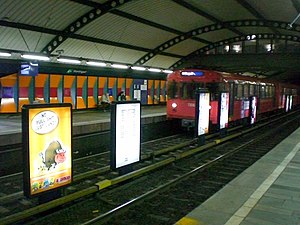
The Oslo Metro is the rapid transit system of Oslo, Norway, operated by Sporveien T-banen on contract from the transit authority Ruter. The network consists of five lines that all run through the city centre, with a total length of 85 kilometres (53 mi), serving 101 stations of which 17 are underground or indoors. In addition to serving 14 out of the 15 boroughs of Oslo, two lines run to Kolsås and Østerås, in the neighboring municipality of Bærum. In 2016, the system had an annual ridership of 118 million.

Sporveien Oslo AS is a municipally owned public transport operator in Oslo, Norway. It operates the trackage and maintains the stock of the Oslo Metro and Oslo Tramway. In 2022, its 3,306 employees transported 217 million passengers. Since 2008 it has operated on contract with the public transport authority Ruter.

Nationaltheatret Station is an underground railway station on the Drammen Line serving Vika and the central business district of Oslo, Norway. It is the second-busiest railway station in Norway, behind Oslo Central Station (Oslo S), from which Nationaltheatret is 1.4 kilometers (0.9 mi) away. Owned and operated by Bane NOR, Nationaltheatret serves regional services to the Vestfold Line and the Oslo Commuter Rail operated by Vy, intercity services on the Sørland Line operated by Go-Ahead Norge, and the Airport Express Train.

Jernbanetorget is both a rapid transit station on the Oslo Metro and a tram stop of the Oslo Tramway. The metro station is in the Common Tunnel used by all lines under the city centre. It is located between Stortinget to the west and Grønland to the east. Until the construction of the station at Stortinget, Jernbanetorget was the end station for the eastern lines in downtown. Along with the Oslo Central Station, Oslo Bus Terminal and the tram and bus station above ground, Jernbanetorget is the largest transport hub in Norway.
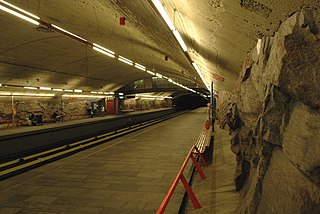
The Grorud Line is a 13.0-kilometer long (8.1 mi) line on the Oslo Metro between Tøyen and Vestli in Oslo, Norway. Built as a mix of underground, at ground level and as an elevated line, it runs through the northern part of Groruddalen, serving such neighborhoods as Grorud, Romsås and Stovner. Line 5 runs along the entire line four times per hour. Line 4 runs between Vestli and Økern before branching off on the Løren Line to get onto the Ring Line. With 40,000 daily riders, the Grorud Line is the busiest branch of the metro.
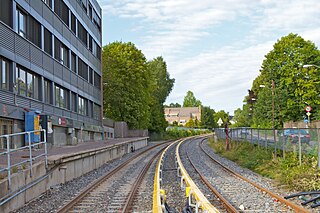
The Holmenkollen Line is an 11.4-kilometre-long (7.1 mi) Oslo Metro line which runs between Majorstuen and Nordmarka in Oslo, Norway. Operating as Metro Line 1, it is the route with the fewest passengers and the only one still to have level crossings and short station platforms. The line runs mostly through residential areas of detached houses, and the upper parts of the line principally serve the recreational area of Nordmarka. Holmenkollen Station is located close to Holmenkollen National Arena which hosts international Nordic skiing tournaments. Voksenkollen Station is not far from Oslo Vinterpark (Winter) and the Oslo Sommerpark (Summer).

Majorstuen is a subway station on the Oslo Metro and a tram stop on the Briskeby Line of the Oslo Tramway. It is located in the Majorstuen neighborhood in the Frogner borough.

The Sognsvann Line is a rapid transit line on the Oslo Metro of Norway. It branches from the Common Tunnel at Majorstuen and runs 6.0 kilometers (3.7 mi) to Sognsvann. After Ullevål stadion, the Ring Line branches off. The Sognsvann Line serves the northwestern and northern neighborhoods of Oslo, mostly within the borough of Nordre Aker. The line is owned and maintained by Kollektivtransportproduksjon and has nine stations. The western end of line 5 serves the entire line. Line 4 and the eastern end of line 5 serve the southern part of the line up to Ullevål stadion before branching off and continuing along the Ring Line. This gives an average five-minute headway on the southern part and an average fifteen-minute headway on the northern part of the line.

The Østensjø Line is a 9.0-kilometre (5.6 mi) line on the Oslo Metro which runs from Brynseng to Mortensrud. It further shares track with the Lambertseter Line along the 2.5-kilometre (1.6 mi) section from Tøyen to Brynseng. The line runs through the primary residential areas of Bøler, Østensjø and Søndre Nordstrand. The line is served by Line 3 of the metro.

The Kolsås Line is a 12.1-kilometer (7.5 mi) line of the Oslo Metro. It branches off from the Røa Line at Smestad Station and runs through western Oslo and Bærum to Kolsås Station. It serves the neighborhoods of Ullernåsen, Øraker, Jar, Bekkestua, Haslum, Gjettum and Kolsås. It is served by Line 3 of the metro at a 15-minute headway. The section from Jar to Bekkestua is built as a dual system with overhead wires, allowing Line 13 of the Oslo Tramway to continue from the Lilleaker Line to Bekkestua every ten minutes.

The Lambertseter Line is a 5.9-kilometer (3.7 mi) line on the Oslo Metro which runs from Brynseng to Bergkrystallen. It further shares track with the Østensjø Line along the 2.5-kilometer (1.6 mi) section from Tøyen to Brynseng. The line runs through a primary residential area of Nordstrand, serving neighborhoods such as Manglerud, Ryen and Lambertseter. The line is served by Line 4 of the metro, which runs every fifteen minutes. This is supplemented by Line 1 that is extended to Bergkrystallen between 6:30 and 19 on weekdays, giving a combined frequency of eight trains per hour.
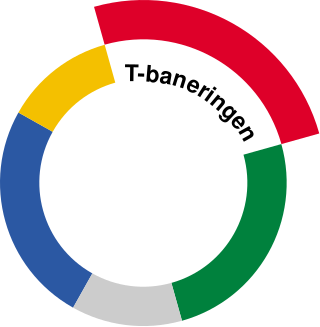
The Ring Line is the newest rapid transit loop line of the Oslo Metro of Oslo, Norway. It connects to the Sognsvann Line in the west and the Grorud Line in the east; along with these two lines and the Common Tunnel, the Ring Line creates a loop serving both the city centre and Nordre Aker borough. The 5.0 kilometres (3.1 mi)-long line has three stations: Nydalen, Storo and Sinsen. Four-fifths of the line runs within two tunnels, with the 1.0-kilometer (0.62 mi) section between Storo and Sinsen, including both stations, being the only at-grade part. The line connects to the Grorud Line north of Carl Berners plass and with the Sognsvann Line north of Ullevål stadion.
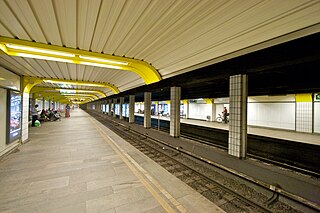
The Common Tunnel, sometimes called the Common Line, is a 7.3-kilometer (4.5 mi) long tunnel of the Oslo Metro which runs through the city center of Oslo, Norway. The name derives from the fact that all five lines of the metro use the tunnel, which runs from Majorstuen to Tøyen. The section has six stations, including the four busiest on the metro.

AS Oslo Sporveier is a defunct municipal owned company responsible for public transport in Oslo, Norway. It was created in 1924 to take over the city's two private tram companies. In 1927 its started with bus transport, including from 1940 to 1968 trolleybuses. Since 1966 rapid transit and from 1985 water buses have also been operated by the company. It was split into two separate companies in 2006; Kollektivtransportproduksjon took over the operation while Oslo Public Transport Administration was responsible for buying the services, fare regulation and marketing. The latter merged into Ruter in 2008, when the Oslo Sporveier brand was discontinued.

Nationaltheatret is an underground metro station and tram stop serving Vika and the city center of Oslo, Norway. It is located on the Common Tunnel of the Oslo Metro and on the Briskeby Line of the Oslo Tramway. Also located at the same place is Nationaltheatret Station of the Drammen Line. The station is served by all five lines of the metro, and lines 11 and 13 of the tramway. In addition, several bus services call at the station. It is named for the National Theatre located nearby.

The Briskeby Line is a line of the Oslo Tramway in Norway. It runs westwards from Jernbanetorget in the city center, passing through the neighborhoods of Briskeby and Uranienborg before reaching its terminus at Majorstuen. The section from Jernbanetorget to Inkognitogata is shared with the Skøyen Line; on this section it connects with the important transport hub Nationatheatret. This part is variously served by route 11, 12 and 13. From the Inkognitogata stop, the line moves through the residential areas around the Royal Palace, in the streets named Riddervolds gate, Briskebyveien, Holtegata and Bogstadveien. The part of the line in Bogstadveien from Majorstuen to Rosenborg is also served by route 19, which operates the Homansbyen Line.

The history of the Oslo Tramway and Oslo Metro in Oslo, Norway, starts in 1875, when Kristiania Sporveisselskab (KSS) opened two horsecar lines through the city centre. In 1894, Kristiania Elektriske Sporvei (KES) built the first electric street tramways, which ran west from the city centre. Within six years, all tramways were electric. The city council established Kristiania Kommunale Sporveie (KKS) in 1899, which built three lines before it was sold to KSS six years later. Both KSS and KES were taken over by the municipality in 1924, becoming Oslo Sporveier. The company gradually expanded the city tram network, which reached its peak length in 1939.
Homansbyen is a tram stop located at Homansbyen in Frogner borough of Oslo, Norway. It is on the Homansbyen Line, a short line that connects the Briskeby Line and Ullevål Hageby Line of Oslo Tramway, and is served by line 19 using SL79 trams. This line is the shortest of the three tram lines that connect the city centre with Majorstuen. The city has planned to build a new rapid transit station for the Oslo T-bane at Homansbyen, but as of 2017 this has not been developed.
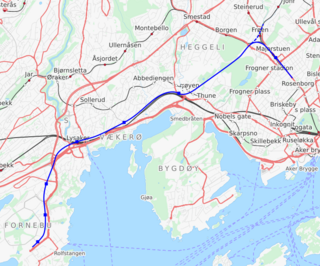
The Fornebu Line is an under construction rail line which will serve the peninsula of Fornebu in Bærum, Norway. The line is under construction and the transit agency Ruter is working towards connecting it to the Oslo Metro. The line has at various stages been proposed as an automated people mover, tram-train, tramway, light rail, stadtbahn, rapid transit, bus rapid transit and commuter rail, with the rapid transit option being selected as the final proposal. The metro line will start at Majorstuen Station and will run entirely in a tunnel for 8,150 meters (26,740 ft). The line will have six stations, at Skøyen, Vækerø, Lysaker, Telenor Arena, Flytårnet and Fornebu Senter. A depot will be built at Fornebu and the line will connect to the metro's Common Tunnel at Majorstuen.

